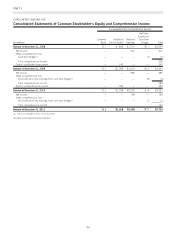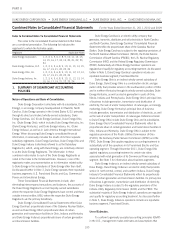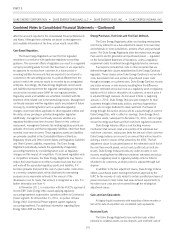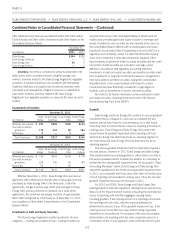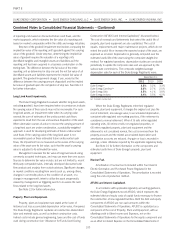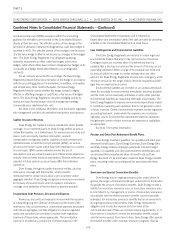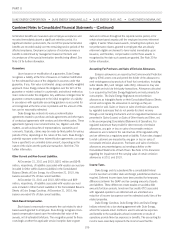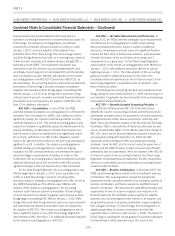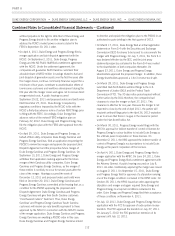Duke Energy 2011 Annual Report Download - page 124
Download and view the complete annual report
Please find page 124 of the 2011 Duke Energy annual report below. You can navigate through the pages in the report by either clicking on the pages listed below, or by using the keyword search tool below to find specific information within the annual report.
PART II
DUKE ENERGY CORPORATION •DUKE ENERGY CAROLINAS, LLC •DUKE ENERGY OHIO, INC. •DUKE ENERGY INDIANA, INC.
Combined Notes to Consolidated Financial Statements – (Continued)
Operations for the debt component. After construction is completed,
the Duke Energy Registrants are permitted to recover these costs
through inclusion in the rate base and the corresponding depreciation
expense or nuclear fuel expense.
AFUDC equity is recorded in the Consolidated Statements of
Operations and is a permanent difference item for income tax
purposes (i.e., a permanent difference between financial statement
and income tax reporting), thus reducing the Duke Energy
Registrants’ effective tax rate during the construction phase in which
AFUDC equity is being recorded. The effective tax rate is
subsequently increased in future periods when the completed
property, plant and equipment is placed in service and depreciation
of the AFUDC equity commences. See Note 22 for information
related to the impacts of AFUDC equity on the Duke Energy
Registrants’ effective tax rate.
For non-regulated operations, interest is capitalized during the
construction phase in accordance with the applicable accounting
guidance.
Asset Retirement Obligations.
The Duke Energy Registrants recognize asset retirement
obligations for legal obligations associated with the retirement of long-
lived assets that result from the acquisition, construction,
development and/or normal use of the asset, and for conditional asset
retirement obligations. The term conditional asset retirement
obligation refers to a legal obligation to perform an asset retirement
activity in which the timing and (or) method of settlement are
conditional on a future event that may or may not be within the
control of the entity. The obligation to perform the asset retirement
activity is unconditional even though uncertainty exists about the
timing and (or) method of settlement. Thus, the timing and (or)
method of settlement may be conditional on a future event. When
recording an asset retirement obligation, the present value of the
projected liability is recognized in the period in which it is incurred, if
areasonableestimateoffairvaluecanbemade.Thepresentvalueof
the liability is added to the carrying amount of the associated asset.
This additional carrying amount is then depreciated over the
estimated useful life of the asset.
The present value of the initial obligation and subsequent
updates are based on discounted cash flows, which include
estimates regarding the timing of future cash flows, the selection of
discount rates and cost escalation rates, among other factors. These
underlying assumptions and estimates are made as of a point in time
and are subject to change. The obligations for nuclear
decommissioning are based on site-specific cost studies and assume
prompt dismantlement, which reflects dismantling the site after
operations are ceased. The nuclear decommissioning asset retirement
obligation also assumes Duke Energy Carolinas will store spent fuel
on site until such time that it can be transferred to a DOE facility.
SeeNote9forfurtherinformationregardingTheDukeEnergy
Registrants’ asset retirement obligations.
Revenue Recognition and Unbilled Revenue.
Revenues on sales of electricity and gas are recognized when
either the service is provided or the product is delivered. Unbilled
retail revenues are estimated by applying average revenue per
kilowatt-hour or per thousand cubic feet (Mcf) for all customer classes
to the number of estimated kilowatt-hours or Mcfs delivered but not
billed. Unbilled wholesale energy revenues are calculated by applying
the contractual rate per megawatt-hour (MWh) to the number of
estimated MWh delivered but not yet billed. Unbilled wholesale
demand revenues are calculated by applying the contractual rate per
megawatt (MW) to the MW volume delivered but not yet billed. The
amount of unbilled revenues can vary significantly from period to
period as a result of numerous factors, including seasonality,
weather, customer usage patterns and customer mix.
At December 31, 2011 and 2010, the Duke Energy registrants
had unbilled revenues within Restricted Receivables of Variable
Interest Entities and Receivables on their respective Consolidated
Balance Sheets as follows:
(in millions)
December 31,
2011
December 31,
2010
Duke Energy $674 $751
Duke Energy Carolinas 293 322
Duke Energy Ohio(a) 50 54
Duke Energy Indiana 212
(a) Primarily relates to wholesale sales within the Commercial Power segment.
Additionally, Duke Energy Ohio, including Duke Energy
Kentucky, and Duke Energy Indiana sell, on a revolving basis, a
portion of their retail and wholesale accounts receivable to CRC.
These transfers meet sales/derecognition criteria and therefore, Duke
Energy Ohio and Duke Energy Indiana, account for the transfers of
receivables to CRC as sales, and accordingly the receivables sold are
not reflected on the Consolidated Balance Sheets of Duke Energy
Ohio and Duke Energy Indiana. Receivables for unbilled revenues
related to retail and wholesale accounts receivable at Duke Energy
Ohio and Duke Energy Indiana included in the sales of accounts
receivable to CRC at December 31, 2011 and 2010 were as follows:
(in millions)
December 31,
2011
December 31,
2010
Duke Energy Ohio $89 $112
Duke Energy Indiana 115 125
See Note 17 for additional information.
Accounting for Risk Management, Hedging Activities and Financial
Instruments.
The Duke Energy Registrants may use a number of different
derivative and non-derivative instruments in connection with its
commodity price, interest rate and foreign currency risk management
activities, including swaps, futures, forwards and options. All
derivative instruments except for those that qualify for the normal
104







